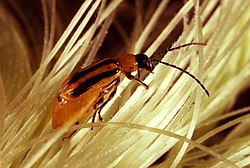 Quantifying Corn Rootworm Damage
Quantifying Corn Rootworm Damage
Every year farmers spend a lot of money trying to control corn rootworm larvae, which are a significant threat to maize production in the United States and, more recently, in Europe.
University of Illinois researchers have been working on validating a model for estimating damage functions.
Nicholas Tinsley, a doctoral candidate in crop sciences, has refined a model developed in 2009 by researchers at the University of Wisconsin and in Brescia, Italy, to describe the relationship between root injury caused by these pests and yield loss. He used the equivalent of 19 years of data collected by personnel from the Insect Management and Insecticide Evaluation Program in the U of I Department of Crop Sciences
“Every year we evaluate a number of different management tactics for corn rootworm; these include soil insecticides and Bt traits,” Tinsley explained. “We do that at a number of different locations on university research farms.”
Tinsley took more than 7,000 data points from field crop insect management trials at Urbana, Perry, Monmouth, and DeKalb for 2005-2011. These trials measured root injury on a 0-3 node-injury scale and mechanically harvested the center two rows of each plot after the crop reached maturity to calculate yield. The results suggested that yield was reduced by 15 percent for each node of roots lost.
Two components had a statistically significant effect variance in the data–location and experimental error. Year had no significant effect.
Tinsley attributes the location effect to differences in weather characteristics and in soil type. “The larva doesn’t really burrow through the soil, it exploits existing soil pores. If you have smaller soil pores, it’s not able to navigate through the soil and find those roots very well,” he said.
The large experimental error indicates that a significant amount of the variability remains unexplained. Tinsley said that this is not surprising considering that yield and proportional yield loss in the experiments varied considerably, probably due to differences among hybrids in yield potential and response to environmental conditions. Other factors that may have contributed to the variability include planting date, planting population, crop emergence, moisture at harvest, and management tactics.
“This not a model that a farmer can use to say, ‘What is my yield loss going to be like this year?'” said Tinsley. “You just don’t know what some of these things that are affecting the error are going to do.”
The model may, however, be useful to help economists to estimate the effect of corn rootworm. “That’s when a model like this can become really handy,” he continued.
Tinsley said that further directions for this research include developing collaborations with other states. “If we extend to the western Corn Belt where it may be drier, we might start to see differences between two different regions in the relationship,” he said.
Another direction is to explicitly model heat stress and moisture stress into the model, perhaps as a covariate. Such an analysis would look at the effects of combinations of factors.
“For example, if I have one node of roots destroyed but I have 10 inches of moisture stress, what’s going to happen as compared to what happens if I have one node of root injury but no moisture stress,” he explained.
He noted that many studies have demonstrated that often, when there is neither moisture stress nor excessive heat stress, the injury from corn rootworm does not result in significant yield loss.
Another factor to consider is lodging, when plants with root injury fall over. Lodged plants are very difficult to harvest.
“Under certain circumstances, you can have not very much root injury but a lot of lodging and big yield losses,” Tinsley said. “Under other circumstances, you can have what seems to be a lot of root injury but if there are no big storms and you don’t have any lodging, there may be no yield loss.” Future collaborations in the development of this damage function may include lodging in the model.
